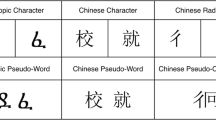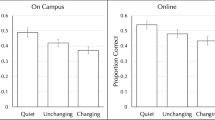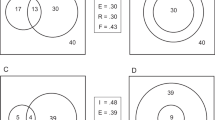Abstract
Two commonplace assumptions about encoding are that sentences are encoded and recognized on the basis of their semantic features primarily and that information regarding form features such as typography is typically ignored or discarded. These assumptions were tested m the present experiment where, within a signal-detection paradigm, S sorted sentences according to whether he had seen them before or not (old vs new) and, if they were old, whether their reappearance was in the same typography as on the first occurrence or a different one. Of the two typographies, one was familiar and the other unfamiliar. Results show that a considerable amount of information regarding surface features is stored for many minutes and that ease of initial encoding is inversely related to likelihood of subsequent recognition: sentences in the unfamiliar typography were remembered better. The results are probably not due to time spent encoding; control tests suggest that time spent encoding a difficult typography does not by itself increase recognition of the semantic content embodied in the typography. Other control tests show that pictorial features or images of the sentences play no significant role in their subsequent recognition. One interpretation of the results is that the analytic activities or cognitive operations that characterize initial acquisition play a significant role in subsequent recognition.
Article PDF
Similar content being viewed by others
Explore related subjects
Discover the latest articles and news from researchers in related subjects, suggested using machine learning.Avoid common mistakes on your manuscript.
References
Bradley, J. V. Complete- counterbalancing of immediate sequential effects in a latin square design. Journal of the American Statistical Association, 1958, 53, 525–528.
Kolers, P. A. Interlingual word associations. Journal of Verbal Learning & Verbal Behavior, 1963, 2, 291–300.
Kolers, P. A. Reading and talking bilingually. American Journal of Psychology, 1966, 79, 357–376.
Kolers, P. A. Reading temporally and spatially transformed text. In K. S. Goodman (Ed.),The psycholinguistic nature of the reading process. Detroit: Wayne State University Press, 1968a.
Kolers, P. A. The recognition of geometrically transformed text. Perception & Psychophysics, 1968b, 3, 57–64.
Kolers, P. A. Some problems of classification. In J. F. Kavanagh and I. G. Mattingly (Eds.),Language by, ear and by eye. Cambridge, Mass: M.I.T. Press, 1972.
Kolers, P. A. Remembering trivia. Language & Speech, in press. Kolers, P. A., & Katzman, M. T. Naming sequentially presented letters-and words. Language & Speech, 1966, 9, 84-95.
Kolers, P. A., & Perkins, D. N. Orientation of letters and errors in their recognition. Perception & Psychophysics, 1969, 5, 265–269.
Margrain, S. A. Short-term memory as a function of input modality. Quarterly Journal of Experimental Psychology, 1967, 19, 109–114.
Miller, G. A.Psychology, the science of mental life. New York: Harper & Row, 1962.
Murdock, B. B., & Walker, K. D. Modality effects in free recall. Journal of Verbal Learning & Verbal Behavior, 1969, 8, 665–676.
Author information
Authors and Affiliations
Additional information
This study was assisted under Grant 382 of the Ontario Mental Health Foundation and by the National Research Council of Canada (A 7655). The assistance of Linda Vettor and Stephen Israelstam in collecting and analyzing the data is also gratefully acknowledged. In addition, I thank Robert S. Lockhart and John C. Ogilvie for their helpful advice on aspects of design and analysis and J. Elisabeth Wells for the suggestion regarding dsem. A briefer version of this paper was presented to the Eastern Psychological Association, April 1972.
Rights and permissions
About this article
Cite this article
Kolers, P.A. Remembering operations. Memory & Cognition 1, 347–355 (1973). https://doi.org/10.3758/BF03198119
Received:
Revised:
Issue Date:
DOI: https://doi.org/10.3758/BF03198119




